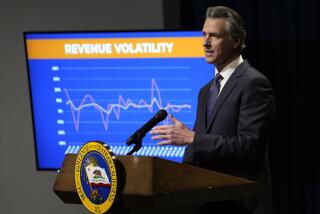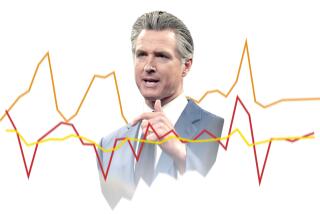The Price of Living in a Fragile Paradise Keeps Getting Steeper
- Share via
Sacramento — Seeing all those eye-popping pictures of hill-slide calamity -- the smashed home, the gargantuan boulder on the road, the washed-out highway -- reminds us that we pay a premium to live in California.
People are drawn here by the siren song of sun, surf and soft climate, then suffer cruel jokes. Mudslides. Crushing waves. Brush fires. Floods. Drought. Avalanches. Earthquakes. All inevitable and often disastrous -- to people, property and the public purse.
We spend tax money trying to prop up hillsides with retaining walls, contain rivers with levees, fortify buildings with earthquake retrofitting. Governments pump scarce water hundreds of miles to arid lands and also plow snow to keep open mountain highways. The sunny state of California spends $25 million a year just removing snow.
A court recently ordered the state to pay Yuba River flood victims $465 million because the government failed to maintain a levee, causing its collapse during a 1986 torrent. Meanwhile, there’s a $600-million backlog in state and federal levee repairs along the Sacramento River.
The state still hasn’t fully caught up with the 1989 Loma Prieta earthquake that wracked the San Francisco Bay Area. Politicians and bureaucrats continue to debate how best to replace a quake-damaged, still-vulnerable span of the Bay Bridge, at a cost now exceeding $5 billion.
There are other tax costs unique to California.
The median home price is $465,000, forcing people to live far from work and commute aggravatingly long distances by car because we haven’t invested enough in light rail and trains. This causes highway wear and tear and a constant demand for expensive, better roads.
Illegal immigrants keep pouring into California because the feds can’t -- or won’t -- protect the border. Businesses and consumers benefit from the cheap labor. But we must educate the immigrants’ children, the courts assert. And if the kids are going to school, we’d better keep them healthy.
The topography, long dry season and unrelenting growth leave California vulnerable to unhealthy, dirty air. So we must regulate industry, even if some complain this is part of the “bad business climate.”
The beautiful beaches must remain accessible to ordinary folk, necessitating government land control. And we want to keep the native salmon running, not only for nature lovers, but for the commercial fishing industry. Government then must tighten the farmers’ water spigot or build off-stream reservoirs.
The more people come to California, the more they get in each other’s face. Crowded conditions incite crime and cost more tax dollars to fight. Big cities generally have worse crime problems than small towns. California keeps getting bigger.
Example: Los Angeles County, with about 10 million residents, had nearly 4,600 crimes for every 100,000 people in 2003, according to the attorney general’s office. Ventura County, with only about 800,000 people, had a much lower crime rate: roughly 2,800 for every 100,000.
Back in the bowels of the budget document Gov. Arnold Schwarzenegger unveiled last week is a fascinating chart that numbers-crunchers update every year. It shows that as population has risen, so has the per capita cost of state government.
One measurement used is “expenditures per $100 of personal income.” In 1950, when California’s population was 10.6 million, state spending per $100 of income was $5.03. This year, with 36.6 million people, it’s a record $9.38.
Certainly, the addition of programs -- Medi-Cal healthcare for the poor, the Proposition 13 financial bailout for schools and local governments -- has contributed to higher state costs. But it’s also logical that the more people there are, the more government they require.
There’s a myth that California is a high tax state. Anti-tax whiners ignore our low property tax. In fact, California has been cutting taxes over the last decade -- one reason the state still faces a $9.1-billion budget deficit despite Schwarzenegger’s massive borrowing. (Yes, another reason is carefree spending during the boom years.)
The Tax Foundation, a Washington research group, last year ranked California in the middle of the pack on state and local taxes. We were No. 26 among the states. Our neighbors? Arizona’s taxes were slightly higher (No. 20) and Nevada’s and Oregon’s a bit lower (30 and 34).
Schwarzenegger has backed himself into a no-tax corner, something that his Republican predecessors -- Pete Wilson, George Deukmejian, Ronald Reagan -- never did. They were willing to temporarily raise taxes to fill a deficit hole.
This governor contends a tax increase would chase away jobs. But lousy transportation and schools -- along with high housing costs -- may be more discouraging to job creators.
It’s ironic that as Schwarzenegger was proposing to avoid a tax hike by again raiding the state highway fund -- seizing $1.3 billion, on top of $1.4 billion last year -- another violent storm was tearing up California roads.
Schwarzenegger has a way out of his corner. When running for governor, he declared: “You can’t ever say never [on taxes] because we could have next year an earthquake. We could have a natural disaster.... “
Catastrophic mudslides can be characterized as a natural disaster. Earthquakes can be made less disastrous by vital bridge work. Floods can be avoided by overdue levee repairs and off-stream storage. Consider it the cost of living in an alluring, growing, fragile state.
George Skelton writes Monday and Thursday. Reach him at george.skelton@latimes.com
More to Read
Sign up for Essential California
The most important California stories and recommendations in your inbox every morning.
You may occasionally receive promotional content from the Los Angeles Times.











